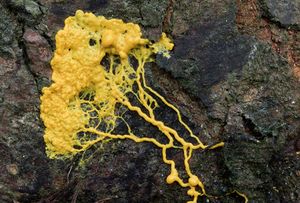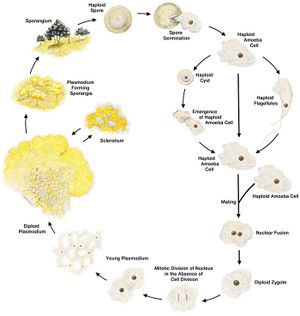Physarum polycephalum
Introduction

Physarum polycephalum is a species of acellular slime molds, or myxomycetes. Despite having a similar name to fungi, these organisms are protists. They are most commonly found in soil, moist vegetation, and the forest floor where it is cool, damp, and dark, where they contribute to the decomposition of dead vegetation. P. polycephalum have very diverse forms of life in a single cycle, as they can range from being a microscopic single-celled amoeba, a multinucleated cell, or plasmodium, that can span several feet, morphing into a hardened mass known as a sclerotium, or forming small, delicate fruiting bodies that produce haploid spores.
Due to its unique life cycle and large plasmodium stage, P. polycephalum is used as a model organism for the studies of cell cycle regulation, cell differentiation, and cellular motility. A multitude of studies have been done on this species of slime mold in order to research and comprehend its methods of communication and apparent intelligence. It is currently unknown as to what the molecular and genetic properties of this organism are that make it capable of having awareness and decision making, as further studies are currently in the process of obtaining conclusive results.
Life Cycle
The P. Polycephalum undergoes many changes during its life.

[1]
[2]
A citation code consists of a hyperlinked reference within "ref" begin and end codes.
Behavioral Characteristics
Optimal Foraging
Cytoplasmic Streaming
Conclusion
Physarum polycephalum appear to exhibit communication and intelligence, unlike most organisms.
References
- ↑ Hodgkin, J. and Partridge, F.A. "Caenorhabditis elegans meets microsporidia: the nematode killers from Paris." 2008. PLoS Biology 6:2634-2637.
- ↑ Bartlett et al.: Oncolytic viruses as therapeutic cancer vaccines. Molecular Cancer 2013 12:103.
- ↑ Lee G, Low RI, Amsterdam EA, Demaria AN, Huber PW, Mason DT. Hemodynamic effects of morphine and nalbuphine in acute myocardial infarction. Clinical Pharmacology & Therapeutics. 1981 May;29(5):576-81.
Edited by Freya Beinart, student of Joan Slonczewski for BIOL 116 Information in Living Systems, 2020, Kenyon College.
